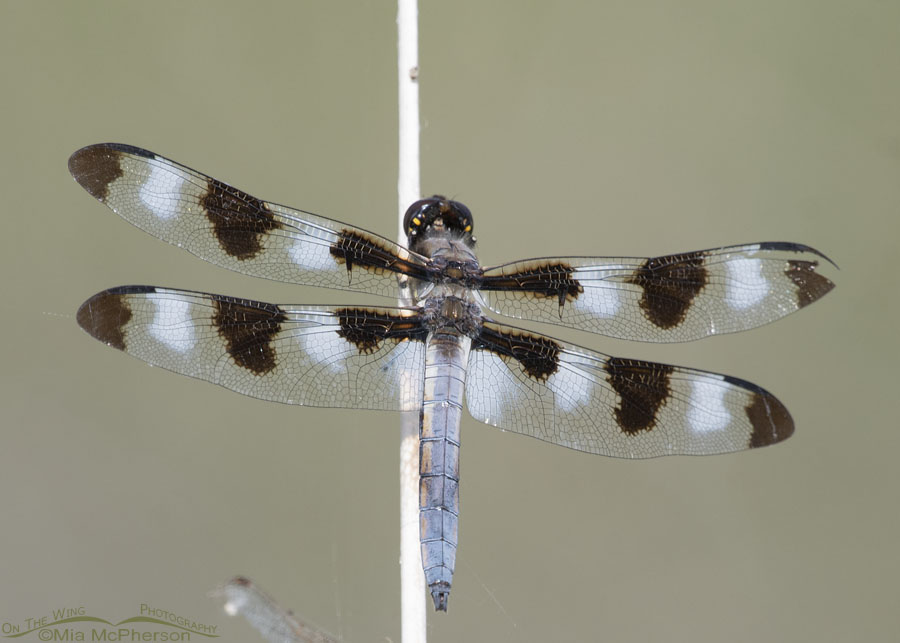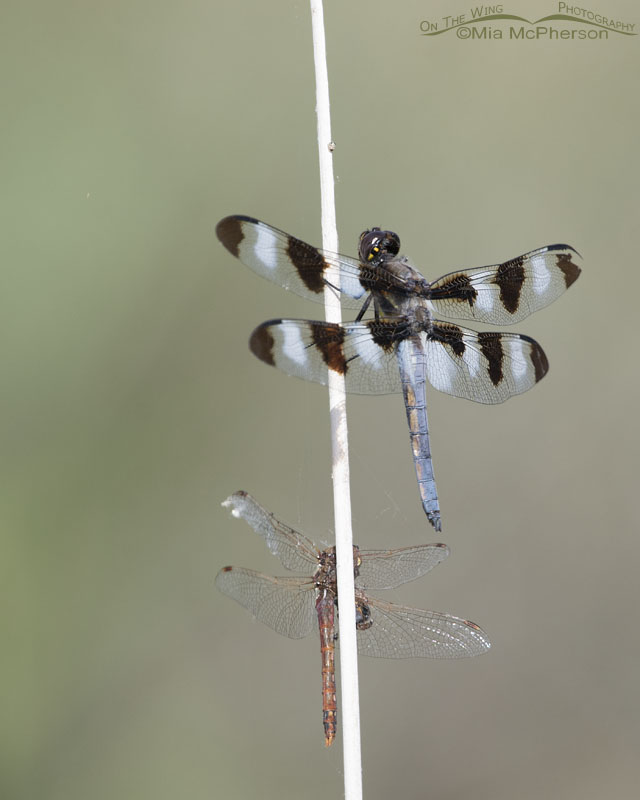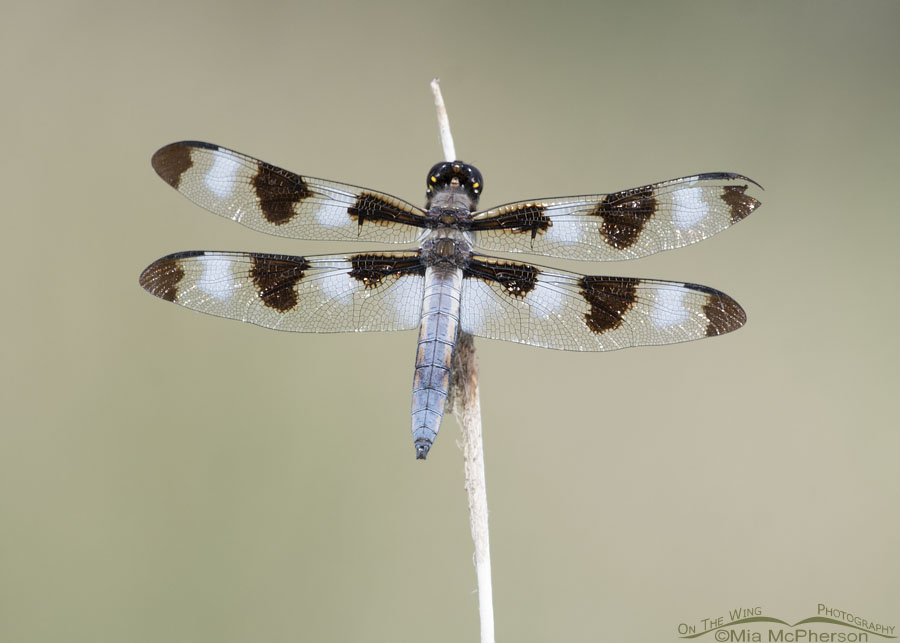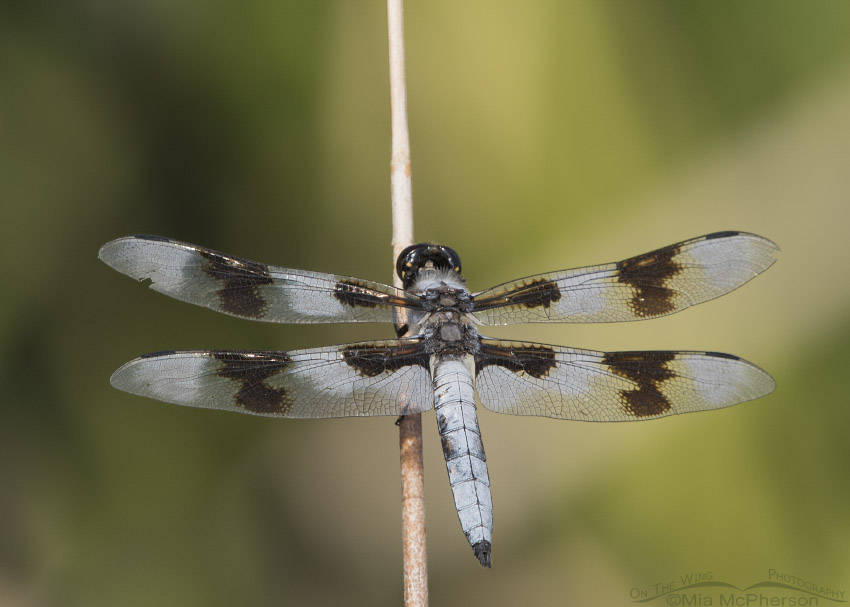 Male Twelve-spotted Skimmer dragonfly in northern Utah – Nikon D500, f7.1, 1/1250, ISO 400, Nikkor 500mm VR with 1.4x TC, natural light
Male Twelve-spotted Skimmer dragonfly in northern Utah – Nikon D500, f7.1, 1/1250, ISO 400, Nikkor 500mm VR with 1.4x TC, natural light
Anyone who knows me, even just a little bit, knows I can’t resist photographing dragonflies when I don’t have birds in my viewfinder. Sometimes even when there are birds nearby.
Before I developed my passion, aka obsession, for photographing birds and prior to purchasing my long lenses I could be found walking around gardens and wild areas of Florida photographing flowers, spiders, butterflies, bees, and dragonflies. I learned there that if I walked slowly and moved cautiously I could photograph the bees, butterflies, and dragonflies even with a simple point & shoot camera.
Now that I have longer lenses there are times I can easily photograph dragonflies from mobile blinds.
 Male Twelve-spotted Skimmer above a deceased Variegated Meadowhawk – Nikon D500, f7.1, 1/1250, ISO 400, Nikkor 500mm VR with 1.4x TC, natural light
Male Twelve-spotted Skimmer above a deceased Variegated Meadowhawk – Nikon D500, f7.1, 1/1250, ISO 400, Nikkor 500mm VR with 1.4x TC, natural light
Five days ago I photographed a lifer dragonfly when I found a male Twelve-spotted Skimmer that was hanging around a spring-fed seep next to a gravel road in Box Elder County.
For a bit it was also hanging around a deceased Variegated Meadowhawk dragonfly that was hung up in a spider web that was wrapped around a cattail.
Until five days ago I’d never seen or photographed a Twelve-spotted Skimmer.
 Resting male Twelve-spotted Skimmer dragonfly – Nikon D500, f7.1, 1/1000, ISO 400, +0.7 EV, Nikkor 500mm VR with 1.4x TC, natural light
Resting male Twelve-spotted Skimmer dragonfly – Nikon D500, f7.1, 1/1000, ISO 400, +0.7 EV, Nikkor 500mm VR with 1.4x TC, natural light
I do wish the Twelve-spotted Skimmer had turned around to look at me when it flew to the top of the cattail but I am glad I had it in my viewfinder even for a short period of time.
 Eight-spotted Skimmer male – Nikon D810, f11, 1/500, ISO 400, -0.3 EV, Nikkor 500mm VR with 1.4x TC, natural light
Eight-spotted Skimmer male – Nikon D810, f11, 1/500, ISO 400, -0.3 EV, Nikkor 500mm VR with 1.4x TC, natural light
We also have Eight-spotted Skimmer dragonflies in northern Utah that look very similar to the Twelve-spotted Skimmers so I thought I would share a photo of one for visual comparison. Looking at the two dragonflies quickly a person might think that they are the same species but differences stand out if you count the dark spots on their wings!
Eight-spotted Skimmers (Libellula forensis) have two large, dark patches or spots per wing and Twelve-spotted Skimmers (Libellula pulchella) have three per wing.
What can I say? I love birds the most but I also enjoy photographing other things with wings.
Life is good. Stay safe.
Mia
Click here to see more of my insect and spider photos.


Mia, these are such beautiful photos and your lesson about them adds a special touch. Thank you so much.
That is quite the showy skimmer!
Dragonflies are such a delight! Did you happen to see the USFWS Instagram post from a few days ago? They highlighted some of the Alaskan species.
Great shots; Exquisite detail. Thanks Mia.
Thanks for the comparison photo (8-spotted). Turns out that is what I took a photo of last week. Glad to have the ID!! Love reading your blog each morning. Our area of the country is loaded with terrain similar to where you travel on your photography adventures, so I’ve been inspired to stop, slow down, and spend time in places I never would have looked at twice before. It is amazing how many different birds and other small critters I’ve been able to photograph. Keep up the inspirational work!
Wonderful.
I share your love and admire your photos.
More beautiful work. Thanks for sharing.
Id of dragonflies can get complicated. I never knew there were so many varieties until I purchased a book to identify them.
Beautiful photos!
I love dragonflies and enjoyed this post. Wikipedia mentions a few interesting facts: “Fossils of very large dragonfly ancestors in the Protodonata are found from 325 million years ago in Upper Carboniferous rocks; these had wingspans up to about 750 mm (30 in).“
I love dragonflies and damselflies…so this is a special treat..thank you
Oh my goodness, they are pretty. I have only see small dragonflies that are a blue or pink or purple in colors. They are pretty small. I have found some larger ones in the mountains, but they are never resting so have no idea what they are like up close. Thanks for the pictures, and have a good day.
Thanks for sharing these. We get the Twelve-spotted Skimmer here all summer long around local lakes but I never knew what they were called. Thanks for the ID.